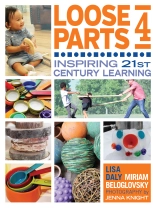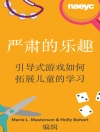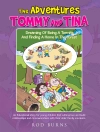Loose parts are natural or synthetic found, bought, or upcycled materials—acorns, hardware, stones, aluminum foil, fabric scraps, for example—that children can move, manipulate, control, and change within their play. Loose parts capture children’s curiosity, give free rein to their imagination, and encourage creativity.
In the newest installment of the wildly popular, award-winning Loose Parts series, Lisa Daly and Miriam Beloglovsky focus on including families and competency building. With inspiring full-color photographs
Loose Parts 4 is organized around competencies and life skills children need for success in the future: knowingness, engagement, risk, connections, leadership, innovative thinking, and creativity.
Lisa and Miriam explain the value of loose parts, detail how to integrate loose parts into the environment and children’s play, and specifically focus on loose parts for children in family environments—helping educators engage families and extend learning beyond the classroom.
Spis treści
Part 1 Introduction
Part 2 Engagement: Children as Meaning Makers
Chapter 1 Focus and Concentration
Chapter 2 Children as Scientist
Chapter 3 Productive Agency
Chapter 4 The Power of Solitude
Part 3 Risk: Taking on Challenges
Chapter 5 Learning About Risk Taking Capacities
Chapter 6 Taking Physical Risks
Chapter 7 Socio-Emotional Risk
Chapter 8 Intellectual Risks
Part 4 Leadership Is Learning
Chapter 9 Open-mindedness and Perspective-Taking
Chapter 10 Altruism and Social Justice
Chapter 11 Taking a Global Perspective
Chapter 12 Building Sustainability
Part 5 Knowingness: Children’s Way of Knowing
Chapter 13 Self-Awareness, Self-Knowledge
Chapter 14 Identity and Learning to Be
Chapter 15 Critical Reflection
Chapter 16 Adaptability, Resilience, and Flexibility
Part 6 Connections: An Essential Element in Development
Chapter 17 Creating a Sense of Belonging
Chapter 18 Young Children as Skillful Communicators
Chapter 19 Building Empathy
Chapter 20 Collaboration: Moral Development, Intuition, and Negotiation
Part 7 Innovative Thinking
Chapter 21 Reframing Opportunity through Design Thinking
Chapter 22 Inquisitiveness, Curiosity and a Sense of Wonder
Chapter 23 The Cycle of Learning
Chapter 24 Questions Without Answers
Part 8 Creativity
Chapter 25 Intellectual Playfulness
Chapter 26 Having a Keen Sense of Humor
Chapter 27 Willing to Go Beyond the Rules
Chapter 28 Enjoyment of Aesthetic Expressions
O autorze
Lisa Daly, MA, is a professor of early childhood education at Folsom Lake College in Folsom, California. She has over thirty years of experience as an early childhood teacher, director, and educator. She has served on community and Association for the Education of Young Children (AEYC) boards, including the statewide Child Development Training Consortium advisory board. She is passionate about creative arts and has directed art programs for thousands of children at community family events and camps. She has also presented numerous workshops for educators on art, storytelling, language and literacy, sensory experiences, and music and movement. Lisa is the coauthor of the popular award-winning Loose Parts series and
Early Learning Theories Made Visible.
Miriam Beloglovsky, MA, is a professor of early childhood education at Cosumnes River College in Sacramento, California, and has had the pleasure of advising and guiding students for over twenty-five years. She is a strong advocate for children, youth, and families, and consults and supports a variety of family, children, and youth programs, including THRIVE Family Development Network and My Street of Dreams. She has served as a keynote speaker, presenter, and board member to a number of organizations and conferences. Miriam is the coauthor of the popular award-winning Loose Parts series and
Early Learning Theories Made Visible.












